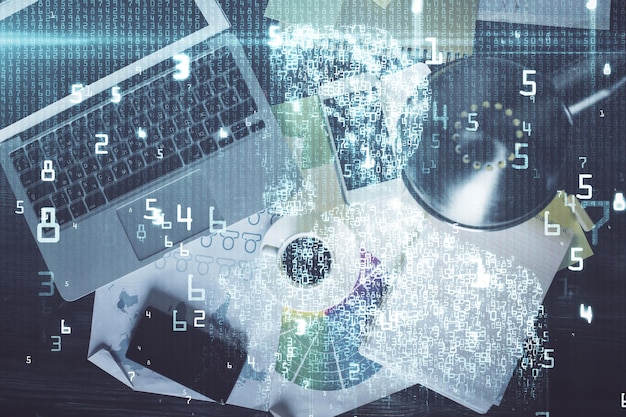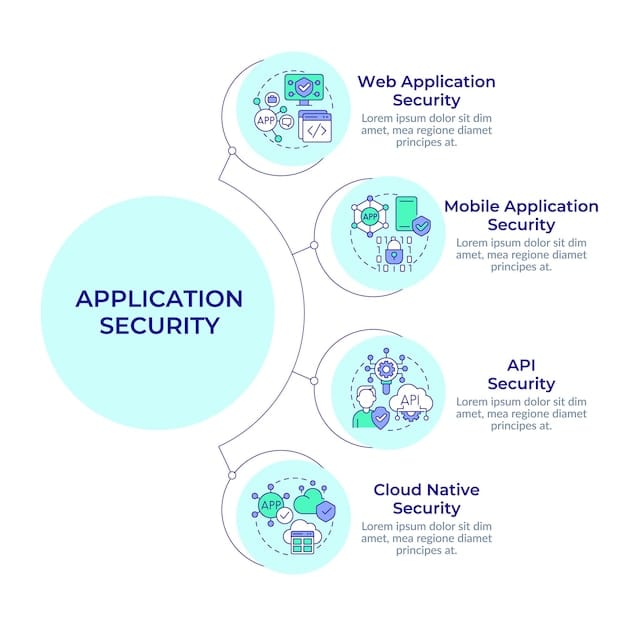Cybersecurity Automation: Protecting US Businesses in 2025

Cybersecurity automation is crucial for US businesses facing increasing and sophisticated cyber threats in 2025, offering proactive defenses, streamlined incident response, and improved overall security posture through AI-driven solutions and automated workflows.
In an era marked by ever-evolving digital threats, safeguarding your business’s sensitive data and critical infrastructure has never been more paramount. As we look ahead to 2025, the landscape of cybersecurity is poised for a significant transformation, with cybersecurity automation emerging as a vital tool for US businesses.
The Rising Tide of Cyber Threats in 2025
The year 2025 promises to bring a new wave of cyber threats, characterized by increased sophistication and malicious intent. Understanding these threats is the first step toward building a robust defense strategy.
Cybercriminals are constantly refining their tactics, making it increasingly difficult for businesses to keep up. Traditional security measures are no longer sufficient to protect against these advanced attacks. The rise of AI-powered attacks further complicates the situation, requiring a more proactive and automated approach to cybersecurity.
Emerging Cyber Threats
- AI-Powered Attacks: Cybercriminals are leveraging AI to automate and enhance their attacks, making them more effective and harder to detect.
- Ransomware as a Service (RaaS): RaaS platforms are lowering the barrier to entry for cybercriminals, leading to a proliferation of ransomware attacks.
- Supply Chain Attacks: Attackers are targeting businesses through their supply chains, compromising multiple organizations with a single breach.
- IoT Vulnerabilities: The increasing number of IoT devices creates new attack vectors, as many devices have weak security measures.
The financial implications of these threats are substantial, with cyberattacks costing US businesses billions of dollars each year. Beyond the financial costs, cyberattacks can damage a company’s reputation, erode customer trust, and disrupt operations.
In conclusion, the cyber threat landscape in 2025 will be more complex and challenging than ever before. Businesses need to adopt advanced cybersecurity measures, including automation, to protect themselves from these evolving threats.
The Power of Cybersecurity Automation
Cybersecurity automation is the use of technology to automate security tasks, such as threat detection, incident response, and vulnerability management. This approach helps businesses improve their security posture, reduce response times, and free up security teams to focus on more strategic initiatives.
Automation can streamline security operations, reduce human error, and improve overall efficiency. By automating repetitive tasks, security teams can focus on more complex challenges, such as analyzing threat intelligence and developing proactive security strategies.

Benefits of Automation
- Improved Threat Detection: Automation can identify threats more quickly and accurately than manual methods.
- Faster Incident Response: Automated incident response workflows can quickly contain and mitigate attacks, reducing the impact on the business.
- Reduced Workload: Automation can free up security teams to focus on more strategic initiatives.
- Enhanced Compliance: Automation can help businesses meet regulatory requirements by ensuring consistent security practices.
The implementation of cybersecurity automation involves integrating various security tools and technologies to create automated workflows. These workflows can be triggered by specific events, such as the detection of a threat or the discovery of a vulnerability.
In conclusion, cybersecurity automation is a powerful tool that can help US businesses strengthen their defenses against evolving cyber threats. By automating security tasks, businesses can improve their security posture, reduce response times, and free up resources to focus on more strategic initiatives.
Key Technologies Driving Cybersecurity Automation
Several key technologies are driving the adoption of cybersecurity automation. These technologies include artificial intelligence (AI), machine learning (ML), security orchestration, automation, and response (SOAR), and threat intelligence platforms (TIPs).
AI and ML algorithms can analyze vast amounts of data to identify patterns and anomalies that indicate a cyber threat. SOAR platforms automate incident response workflows, and TIPs provide valuable threat intelligence to inform security decisions.
AI and Machine Learning in Cybersecurity
AI and ML algorithms are capable of analyzing large datasets to identify potential security breaches by recognizing patterns that deviate from regular activities. This proactive method allows for faster threat detection and response, ultimately reducing the impact of cyberattacks.
Moreover, AI and ML can automate tasks such as vulnerability scanning, patch management, and security configuration, ensuring systems are always up-to-date and secure. The integration of these technologies into cybersecurity strategies provides a more robust and efficient defense against cyber threats.
SOAR Platforms: Orchestration and Automation
Security Orchestration, Automation, and Response (SOAR) platforms are designed to streamline and automate security operations by integrating different security technologies and tools. These platforms enable organizations to define and automate incident response workflows, reducing the time and effort required to handle security incidents.
SOAR platforms gather data from various security tools, analyze it, and orchestrate automated responses based on predefined rules. This ensures that security teams can respond quickly and effectively to incidents, improving the overall security posture of the organization.
In conclusion, AI, ML, and SOAR platforms are essential technologies for cybersecurity automation. These tools enable businesses to improve their threat detection capabilities, automate incident response, and enhance their overall security posture.
Implementing Cybersecurity Automation: A Step-by-Step Guide
Implementing cybersecurity automation requires a strategic approach that aligns with the business’s specific needs and risk profile. This involves assessing current security infrastructure, identifying automation opportunities, and selecting the right tools and technologies.
A well-planned implementation strategy ensures that automation efforts are focused on the areas where they can have the greatest impact. It also helps to avoid common pitfalls, such as over-automation or inadequate integration with existing systems.

Steps for Successful Implementation
- Assess Your Current Security Infrastructure: Evaluate your existing security tools, processes, and resources to identify gaps and areas for improvement.
- Identify Automation Opportunities: Determine which security tasks and processes can be automated to improve efficiency and reduce risk.
- Select the Right Tools and Technologies: Choose automation tools that align with your business needs, budget, and technical capabilities.
- Develop Automated Workflows: Create detailed workflows that define how automation will be used to address specific security challenges.
- Test and Deploy Automated Workflows: Thoroughly test automated workflows in a controlled environment before deploying them in a production environment.
Challenges in implementing cybersecurity automation include the complexity of integrating different security tools, the need for skilled personnel to manage and maintain automated systems, and the potential for false positives. Addressing these challenges requires careful planning, training, and ongoing monitoring.
In conclusion, implementing cybersecurity automation requires a strategic and well-planned approach. By following these steps and addressing potential challenges, US businesses can successfully leverage automation to strengthen their security posture and protect against evolving cyber threats.
Best Practices for Cybersecurity Automation in 2025
To effectively leverage cybersecurity automation, businesses need to adopt best practices that ensure automation efforts align with security goals and deliver tangible benefits.
These practices encompass all aspects of automation, including planning, implementation, monitoring, and maintenance. Embracing best practices helps businesses maximize the value of their automation investments and mitigate potential risks.
Essential Best Practices
- Prioritize Automation Efforts: Focus on automating the most critical security tasks and processes first.
- Integrate Automation with Existing Systems: Ensure that automated systems are seamlessly integrated with your existing security infrastructure to avoid conflicts and gaps.
- Monitor and Maintain Automated Systems: Continuously monitor automated systems to ensure they are functioning correctly and adapt them as needed to address evolving threats.
- Provide Adequate Training: Train security personnel on how to use and manage automated systems effectively.
Measuring the Success of Automation
Key performance indicators (KPIs) can help measure the effectiveness of cybersecurity automation efforts. These KPIs provide valuable insights into the impact of automation on security posture and operational efficiency.
Examples of KPIs include:
- Reduction in incident response time
- Decrease in manual security tasks
- Improvement in threat detection accuracy
- Reduction in security breaches
Tracking these KPIs over time can help businesses assess the value of their automation investments and identify areas for further improvement.
In conclusion, adopting best practices is essential for maximizing the benefits of cybersecurity automation. By prioritizing efforts, integrating systems, monitoring performance, and providing training, US businesses can effectively leverage automation to enhance their security posture and overall operational efficiency.
The Future of Cybersecurity Automation
The future of cybersecurity automation is expected to be shaped by advancements in AI, ML, and other emerging technologies. These advancements will enable more sophisticated and proactive security measures, further enhancing the ability of businesses to protect against evolving cyber threats.
Looking ahead, cybersecurity automation will likely play an even more critical role in protecting US businesses. As cyber threats become more sophisticated and frequent, businesses will need to rely on automation to detect, respond to, and prevent attacks.
Emerging Trends in Cybersecurity Automation
- AI-Driven Threat Hunting: AI algorithms will be used to proactively hunt for threats within the network, identifying anomalies and suspicious activities that might otherwise go unnoticed.
- Autonomous Incident Response: Automated systems will be capable of responding to incidents autonomously, without human intervention, further reducing response times and minimizing the impact of attacks.
- Adaptive Security: Security systems will adapt dynamically to changing threat landscapes, automatically adjusting security policies and configurations to maintain optimal security posture.
In addition to these technological advancements, the regulatory landscape is also expected to influence the future of cybersecurity automation. Compliance requirements and data privacy regulations will drive the adoption of automation to ensure adherence to legal and ethical standards.
In conclusion, the future of cybersecurity automation is bright, with emerging technologies and evolving regulations driving innovation and adoption. As businesses face increasingly sophisticated cyber threats, automation will be essential for maintaining a strong security posture and protecting valuable assets.
| Key Point | Brief Description |
|---|---|
| 🛡️ Threat Landscape | Cyber threats are becoming more sophisticated, requiring advanced defenses. |
| ⚙️ Automation Benefits | Automation enhances threat detection, incident response, and reduces workload. |
| 🤖 Key Technologies | AI, Machine Learning, and SOAR platforms are driving automation. |
| 📊 Measuring Success | KPIs like reduced response time and improved detection accuracy are crucial. |
FAQ
▼
Cybersecurity automation involves using technologies to automate security tasks like threat detection, incident response, and vulnerability management, improving efficiency and security posture.
▼
It is critical because cyber threats are increasing in sophistication; automation enhances protection, reduces response times, and allows for better resource allocation in a challenging landscape.
▼
Key technologies include artificial intelligence (AI), machine learning (ML), security orchestration, automation, and response (SOAR), and threat intelligence platforms (TIPs).
▼
Start by assessing your security, identifying opportunities for automation, choosing the right tools, developing automated workflows, and continually monitoring and maintaining systems.
▼
Prioritize automation, integrate systems seamlessly, monitor performance, provide adequate training, and establish metrics like reduced response time for evaluating success.
Conclusion
As we approach 2025, cybersecurity automation is no longer a luxury but a necessity for US businesses aiming to safeguard themselves against the escalating sophistication of cyber threats. By embracing automation, companies can enhance their threat detection capabilities, streamline incident response, and ultimately fortify their overall security posture in an increasingly perilous digital landscape.





